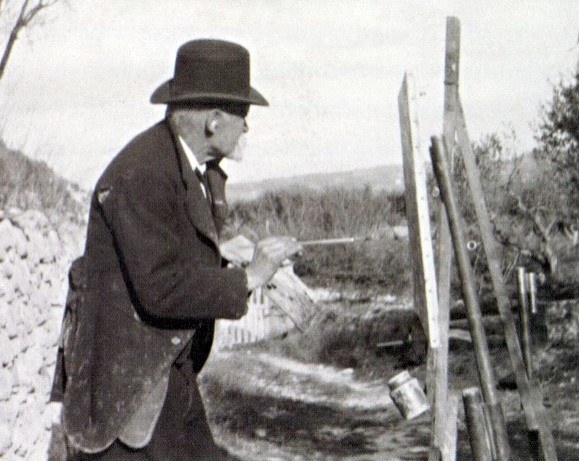To the east of Aix-en-Provence, in the Sainte-Victoire Massif range, towering above the River Arc, stands the distinctive grey limestone silhouette of Mont Sainte-Victoire. The landmark remained a seminal motif for Paul Cézanne (1839 – 1906) between 1877 and his death nearly three decades later, appearing in both oils and watercolours, either dominating the page or hovering on the distant horizon, and clearly identifiable by its flattened summit. What initially appears to be a simple mountain landscape became the catalyst for a complete reinvention of painting by Cézanne, whose innovations would affect Picasso, Braque and generations of artists to come.
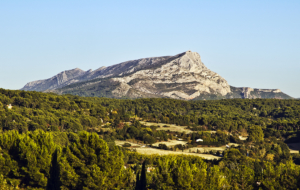

Mont Sainte-Victoire
In Cézanne’s watercolour La Montagne Sainte-Victoire of circa 1890, recently sold by Dickinson, the mountain looms large, its top nearly touching the upper margin of the page. Cézanne depicts the mountain as at once both timeless and ephemeral, ‘a weightless, hovering form, suffused with light like the sky’ (T. Reff, in Cézanne: The Late Work, exh. cat., Museum of Modern Art, New York, 1977, p. 29).
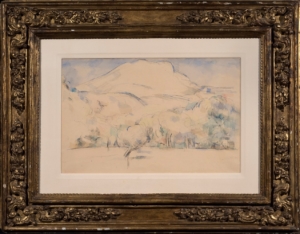

P. Cézanne, La Montagne Sainte-Victoire, c. 1890, watercolour on buff paper. Sold by Dickinson to a private collector
At the time he painted La Montagne Sainte-Victoire, Cézanne was in his mid-50s. He had recently come into a sizeable inheritance following the death of his father, Louis-Auguste, in 1886. Although he now had the means to travel abroad, Cézanne preferred to remain in the vicinity of Aix-en-Provence, where until 1899 he was based at the family home, Jas de Bouffan, bought by Cézanne père in 1859. Cézanne had established a studio there in 1880, painting near the house as well as at Bellevue, to the southwest, where his sister owned a farm.
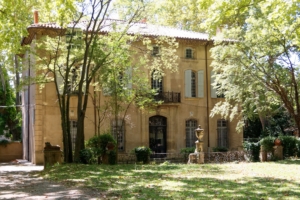

The Bastide du Jas de Bouffan, Aix-en-Provence, in a recent photo
Although it can be difficult to determine the precise spot from which some of the Mont Sainte-Victoire views are taken, many of those from the 1890s were painted in the area around the Bibémus quarry and the Château Noir, roughly halfway between Aix proper and the mountain.
An important aside is a related online exhibition: Princeton University Art Museum’s Cézanne: The Rock and Quarry Paintings. Originally meant to open in Princeton this Spring before travelling to London’s Royal Academy, is the first ever exhibition to focus on Cézanne’s fascination with rock and geological formations. On view are 15 of the most important of these paintings, as well as related watercolour and pen studies lent by various American institutions. The show is accompanied by an insightful video narrated by curator John Elderfield (see video here).
Cézanne’s late watercolours are constructed almost entirely in translucent wash, with the white of the paper assuming a new prominence – a bold departure from traditional Academy teaching.. Beginning in the late 1870s, Cézanne adopted his signature ‘constructive stroke’, a square and diagonal brush mark that declared the supremacy of surface pattern over the perceived texture of the subject itself. And later, circa 1890, Cézanne moved away from his earlier repoussoir compositions, preferring instead to let the mountain stand on its own.
This radical approach to technique and composition, which later caused Picasso to proclaim Cézanne ‘the father of us all’, influenced a coterie of modernists, including Picasso, Braque and Metzinger. The influence was extensive, but Cézanne essentially reduced the visible world into its basic, underlying shapes. His faceted brushstrokes reconstructed nature with geometric forms, flattening the space. Although Cézanne insisted he painted from nature, his practice can be seen as the foundation of modern art, turning established, traditional methods on their head.
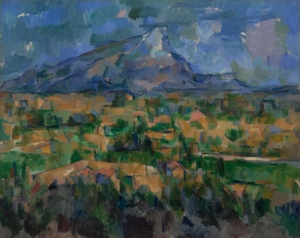

P. Cézanne, Mont Sainte-Victoire, 1902-1904, oil on canvas, Philadelphia Museum of Art, Philadelphia
Cézanne introduced two basic tenets, widely acknowledged as the foundations of Modernism. The first was based on his use of geometry: he built his compositions not with lines, but rather with volumetric planes of colour, fracturing images into distinct parts. These blocks of colour were developed further still by the Cubists, who broke down natural forms into a series of geometric shapes: cubes, triangles, cylinders, etc. And in his later works, Cézanne’s lack of colour afforded him an equally radical method of building compositions by letting the paper or canvas stand for solid forms, as seen in La Montagne Sainte-Victoire.
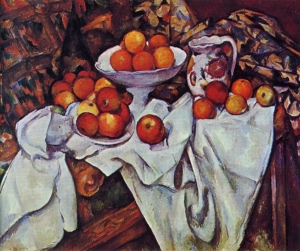

P. Cézanne, Still Life with Apples and Oranges, c. 1899, oil on canvas, Musée d’Orsay, Paris
The second major tenet was Cézanne’s sense of perspective. He abolished absolutely the traditional single-point perspective, instead introducing the notion of multiple simultaneous perspectives. Many critics objected to this new style, among them Louis Vauxcelles, whose disparaging description of Braque’s Maisons et arbre (Houses at L’Estaque) of 1908 – generally considered the first Cubist landscape – would later lend the movement its name; Vauxcelles described Braque’s composition as having ‘bizarreries cubiques’ or ‘cube-like oddities’.
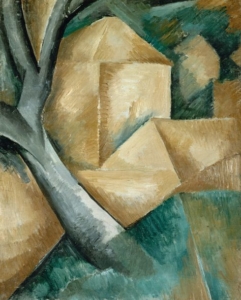

G. Braques, Maisons et arbre (Houses at L’Estaque), 1908, oil on canvas, Lille Metropole Museum of Modern, Contemporary and Outsider Art, Lille
The Cubists, on the other hand – Picasso, Braque, Delaunay, Gris, Léger (who took a Cubist approach to industrial subject matter) and others – were intrigued by, and seized upon, this revolutionary approach. Picasso identified in Cézanne’s work a method for distilling nature into a pure essence, which he then manipulated in every manner possible, most famously in his 1907 Les Demoiselles d’Avignon.
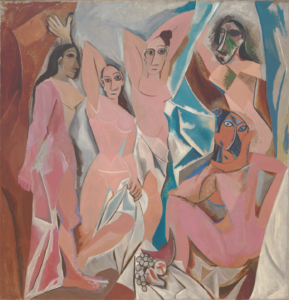

P. Picasso, Les Demoiselles d’Avignon, 1907, oil on canvas, Museum of Modern Art, New York
They all expanded upon Cézanne’s aesthetic by introducing multiple views of the same subject, from different perspectives. The earliest form of Cubism, known as Analytical Cubism, gave way to the vibrant colours of Synthetic Cubism.
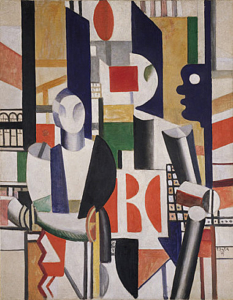

F. Léger, Hommes dans la Ville, 1919, oil on canvas, Solomon R. Guggenheim Museum, New York
Anything was fair game: a vase, a table top, cars, street signs, landscapes, and people. All could be abstracted, flattened and dissected from the side, top to bottom, and presented from simultaneous viewpoints on canvas or paper.
Cézanne’s friend and correspondent, fellow Post-Impressionist Émile Bernard, visited Cézanne in Aix in 1904, and described his working method as ‘remarkable, absolutely different from the usual process, and extremely complicated. He began on the shadow with a single patch, which he then overlapped with a second, then a third, until all those tints, hinging one to another like screens, not only coloured the object but modelled its form’ (quoted in J. Rewald, op. cit., 1983, p. 238). Significantly, Cézanne also allowed each patch to dry fully before applying the subsequent one, so that the translucent colours appear as overlapping yet distinct planes rather than bleeding into one another as in the wet-in-wet technique.
In October 1907, shortly after Cézanne’s death, a retrospective exhibition was staged at the Salon d’Automne; it was here that Picasso, Braque and others fully grasped the importance and potential of Cézanne’s work. Cézanne delivered a groundbreaking approach to the traditional mode of Renaissance and Classical painting. He turned our sense of equilibrium happily upside down by revolutionising the way we, as artists and viewers, build and perceive volume and perspective.
For enquiries about Juan Gris’s Nature Morte, 1916, please contact: [email protected]


